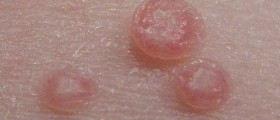The cervix is the distal and narrow portion of the uterus. It represents a connection between the uterus and the vagina. This part of the uterus is cylindrical or conical in shape. During gynecological exam, doctor can inspect and asses only half of its length. This is because the remnant part of the organ is located above the vagina and is not approachable.
The superficial layer of the cervix is combined. Namely, the ectocervix (the part of the cervix closer to the vagina) comprises nonkeratinized stratified squamous cells. On the other hand, the endocervix (the part of the cervix located within the uterus) is made of simple columnar epithelial cells. As it is the case with any other organ, even the cervix can be affected by various lesions some of which are benign, while others represent more serious and even lethal conditions (e.g. cervical cancer).
Benign Cervical Lesions Caused by Inflammation and Infection
Inflammation of the cervix is medically known as cervicitis and it frequently affects women in their reproductive years.
Infectious cervicitis develops due to different microorganisms. The virulence of the infective agent, the epithelial integrity as well as the vaginal pH are three factors which determine susceptibility of the cervix to bacterial infections.
Cervical lesions may be in a form of exophytic or ulcerative changes. Human papilloma virus (HPV), herpes simplex virus (HSV), Treponema pallidum and Haemophilus ducreyi are some potential infective agents responsible for cervical lesions. Mucopurulent cervicitis is a consequence of infection caused by Chlamydia trachomatis and Neisseria gonorrhoeae.
Benign Tumors of the Cervix
There are many cervical tumors which are considered benign and not life-threatening.
The first one is endocervical polyp. This is actually the most common benign growth of the cervix and predominantly affects women between the age of 40 and 60.
Microglandular hyperplasia represents a polypoid growth which does not exceed 2 cm. This cervical lesion develops as a side effect of oral contraceptive therapy.
Squamous papilloma is a benign lesion commonly associated with prolonged inflammation and trauma. The ectocervix is a predilection place for this benign solid tumor.
Leiomyomas are tumors made of smooth muscles. If they affect the cervix, they generally do not grow larger than 10mm.
Mesonephric duct remnants are not a common finding and are identified in approximately 15-20% of serially sectioned cervices. These cervical lesions are actually remnant tissues of the mesonephric (Wolffian) duct.
Cervical lesions caused by endometriosis develop in a form of a mass and cause postcoital bleeding. The lesion is bluish-red or bluish-dark and may range from 1-3mm.
Papillary adenofibroma is a rare tumor of polypoid structure and occasional cystic areas.
Heterologous tissue is a form of a tumor mass which is rarely confirmed in the cervix. Still, once it is formed, it may contain different structures such as cartilage, glia and even skin with its appendages.
And finally, hemangioma of the cervix is a tumor made of abnormal blood vessels. Similarly to hemangioma of other organs in the body, cervical hemangioma may bleed. Due to hemorrhage the tumor is often mistaken for cervical malignancy.
Cervical Pregnancy
Cervical pregnancy is also a possible cause of cervical lesion. Implantation takes place inside the cervical canal. It may be in a form of an exophytic lesion. This lesion eventually starts to bleed and requires proper medical management.
After 1971, DES continued to be prescribed to pregnant women outside the United States and is still available in oral form for human use in some countries, making this a consideration for our international patients. In 2010, the youngest women exposed in the United States to DES are in their forties and the oldest in their early seventies. Most have no reproductive tract abnormalities, although others have an increased risk of anomalies.
- Most CCA has been reported in women younger than 35 years; however, it is essential to identify DES daughters and continue screening them through midlife and beyond. Clear cell adenocarcinoma may present as an abnormal lesion of the vagina or cervix or be identified through cytology. The relative risk of CCA in a DES daughter is 40.7 as compared with that of a nonexposed woman. About 1 to 1.5 in 1000 DES daughters will develop CCA with a peak incident in their late teens to early twenties; however, it has been reported in women in their thirties and forties.
- About one-third of DES daughters have vaginal adenosis and abnormalities of the cervix, including the cockscomb cervix and the cervical collar or hood. Up to two-thirds of DES daughters experiencing infertility have a uterine anomaly, most commonly a T-shaped uterus.
- In appropriately aged women, clinicians should elicit an accurate history of cervical and vaginal abnormalities, including a history of recurrent miscarriage or preterm labor in the patient's mother. DES daughters should receive the following testing annually because routine screening intervals do not apply: physical examination including breast examination and mammography; pelvic examination with inspection and palpation of the vulva, vagina, and cervix; vaginal and cervical cytology; and bimanual examination including rectal examination.








_f_280x120.jpg)









Your thoughts on this
Loading...